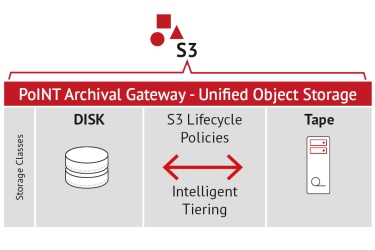Object storage on tape using the S3 interface is a convincing answer to the unabated data growth. In the object storage sector, hard disks are predominantly used. However, with increasing data volumes, there is a need for more cost efficient alternatives – especially for data that does not need to be accessed quickly at present or even in the long term.
Here are our top 5 reasons why an S3 to tape approach is the game changer for your storage strategy:
1.
The standardized S3 interface is perfectly suited for integrating tape into the storage infrastructure because the underlying http protocol meets tape-specific challenges (such as time-outs). For example, file systems do not take into account high latencies, which are characteristic of the storage medium tape. This can lead to problems that an S3 to tape concept avoids.
2.
Software solutions that support S3 to tape store large amounts of data with high performance values. They achieve this, for example, through high scalability and simultaneous writing to multiple media.
3.
On the one hand, an on-prem S3 to tape implementation provides data sovereignty: companies retain control over their data and its security when they store it “in-house”. On the other hand, tape as a typical offline medium and with Air-Gap offers a high level of protection against cybercrime attacks.
4.
All in all, data storage on tape offers high cost efficiency and a higher ROI compared to public cloud storage. By the time a change of cloud provider is necessary, significant egress costs can arise when retrieving data from the cloud. An S3 to tape solution can therefore contribute significantly to cost reduction in the area of storage infrastructure.
5.
Tape storage technology is also characterized by its sustainability: Energy consumption and the associated CO2 emissions are very low – both for storing data on tape and for storing the media. This means that concepts of green IT can be supported with an S3 to tape solution.

